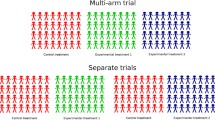Abstract
New statisticians entering industry tend to “test statistical interactions” whenever there is a need. However, in many real-world applications, especially in clinical development of new drugs, most interactions need to be estimated, instead of tested. In this manuscript, the distinction between hypothesis testing and estimation will be articulated, and the use of statistical interactions in clinical development programs will be discussed. According to ICH E-9, the treatment by subgroup interaction should not be included in the prespecified primary statistical analysis model. The reasons behind this ICH E-9 recommendation are also clarified in this manuscript.
Similar content being viewed by others
References
Wasserstein RL, Lazar NA. The ASA’s statement on p-values: context, process, and purpose. The American Statistician. https://doi.org/10.1080/00031305.2016.1154108. Published 2016
Ting N. Confirm and explore, a stepwise approach to clinical trial design. Drug Inform J. 2008:42:545–554.
International Conference on Harmonization (ICH) Topic E9: Statistical principles for clinical trials. European Medicines Agency, 1998.
Wang R, Lagakos SW, Ware JH, Hunter DJ, Drazen JM. Statistics in medicine—reporting of subgroup analyses in clinical trials. N Engl J Med. 2007;357:2189–2194.
Chuang-Stein C, Li Y, Kawai N, Komiyama O, Kuribayashi K. Detecting safety signals in subgroups. In: Jiang Q, Xia HA, eds. Quantitative Evaluation of Safety in Drug Development: Design, Analysis and Reporting. Boca Raton, FL: CRC Press; 2014.
Committee for Medicinal Products for Human Use (CHMP). Guideline on the investigation of subgroups in confirmatory clinical trials (draft). European Medicines Agency, 2014.
Mallinckrodt CH, Lane PW, Schnell D, Peng Y, Mancuso JP. Recommendations for the primary analysis of continuous endpoints in longitudinal clinical trials. Drug Inform J. 2008;42:303–319.
Pocock SJ, Assmann SE, Enos LE, Kasten LE. Subgroup analysis, covariate adjustment and baseline comparisons in clinical trial reporting: current practice and problems. Stat Med. 2002;21:2917–2930.
Lagakos S. “The challenge of subgroup analyses: reporting without distorting.” N Engl J Med. 2006;354:1667–1669.
Chen J, Quan H, Binkowitz B, et al. Assessing consistent treatment effect in a multi-regional clinical trial: a systematic review. Pharm Stat. 2010;9:242–253.
Chen J, Wang H. Multiregional clinical trials: assessing consistency of treatment effect. Multiregional clinical trials for simultaneous global new drug development. New York: CRC Press; 2016.
Zink RC, Shen L, Wolfinger RD, Showalter HDH. “Assessment of methods to identify patient subgroups with enhanced treatment response in randomized clinical trials.” In: Chen Z, Liu A, Qu Y, Tang L, Ting N, Tsong Y, eds. Applied Statistics in Biomedicine and Clinical Trials Design: Selected Papers from 2013 ICSA/ISBS Joint Statistical Meetings. Cham, Switzerland: Springer; 2015.
Author information
Authors and Affiliations
Corresponding author
Rights and permissions
About this article
Cite this article
Ting, N. Statistical Interactions in a Clinical Trial. Ther Innov Regul Sci 52, 14–21 (2018). https://doi.org/10.1177/2168479017716491
Received:
Accepted:
Published:
Issue Date:
DOI: https://doi.org/10.1177/2168479017716491




